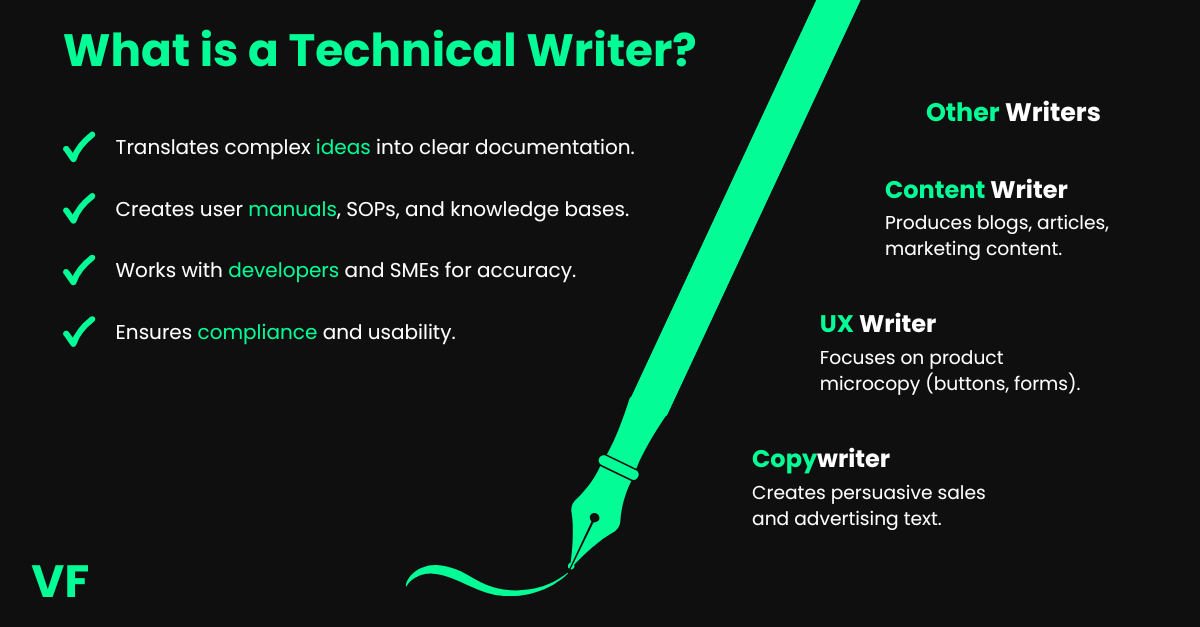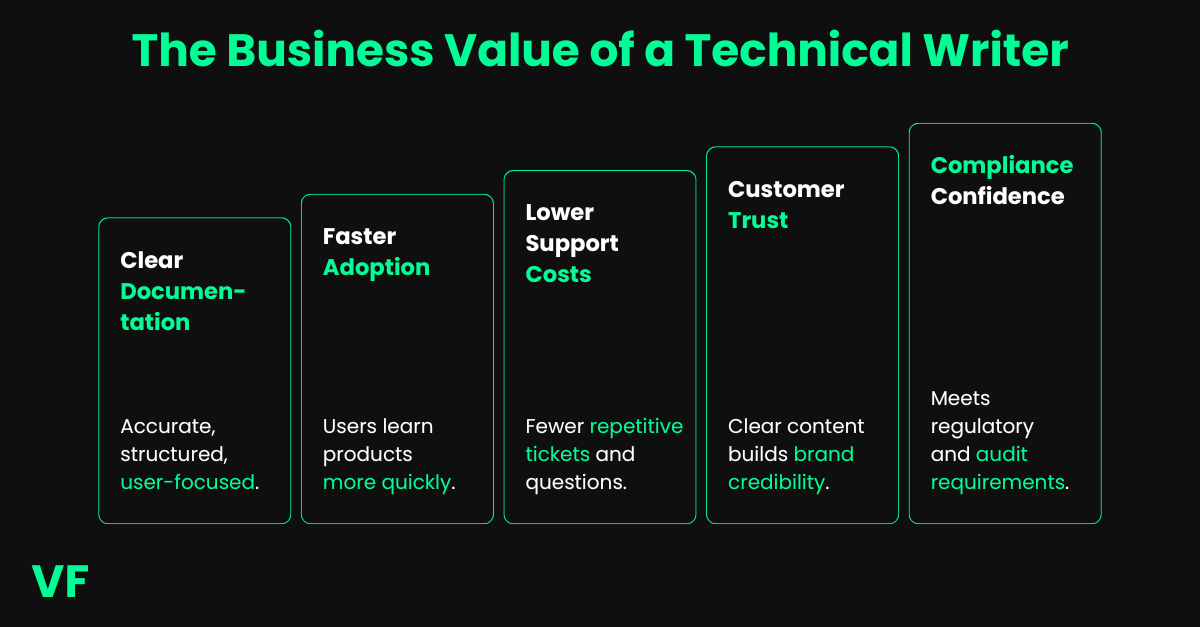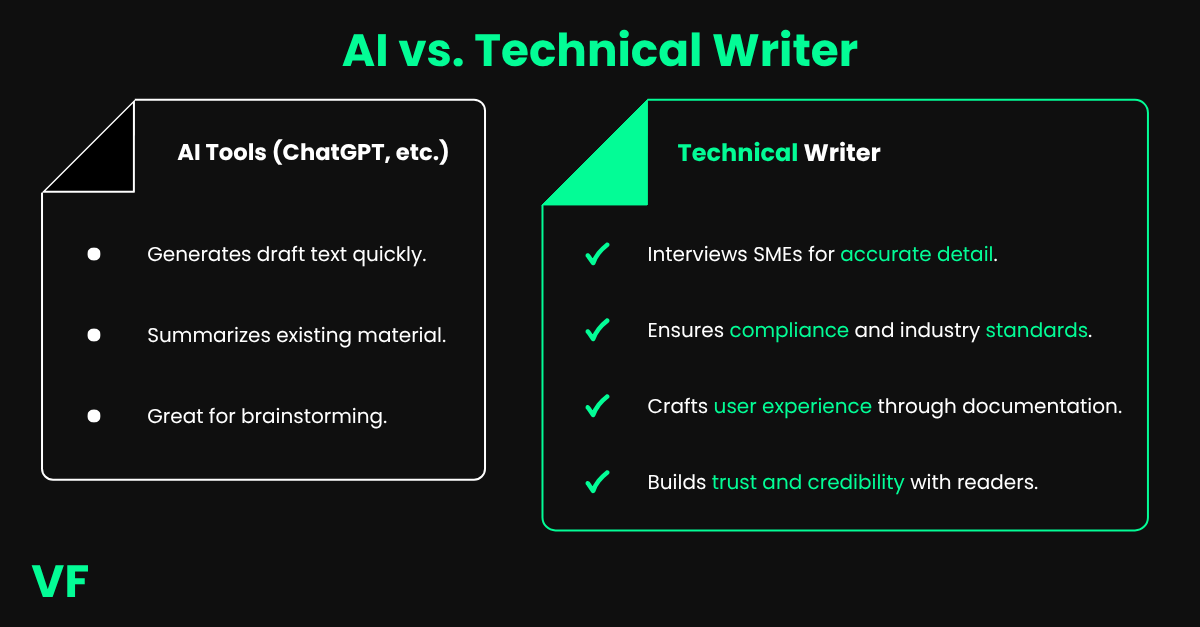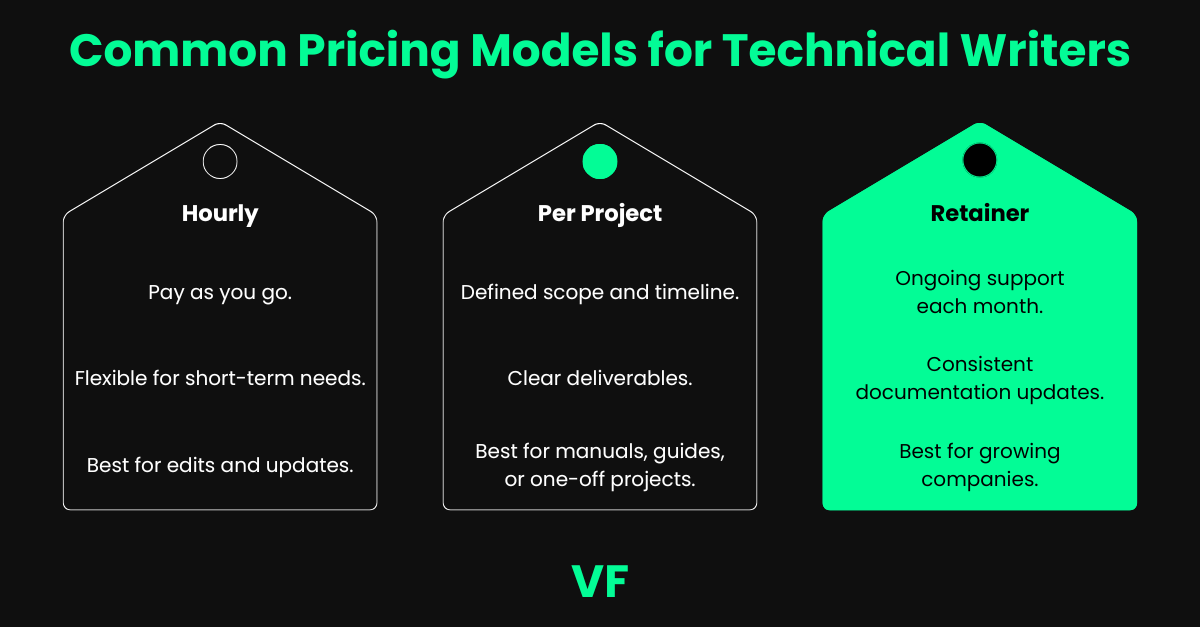Introduction
Ever tried to follow a product guide that left you more lost than helped? Clear, well-written documentation can make all the difference, turning frustration into confidence. A skilled technical writer bridges that gap by transforming complex information into simple, helpful content that empowers users and supports your team, enhancing their overall career prospects. If you’re thinking about bringing one on board, here’s what you need to know before you hire: what they do, why they’re invaluable, and how to find the right fit for your business.
What is a Technical Writer (and Why They Matter for Your Business)?

A technical writer helps bridge the gap between complex information and the people who need to understand it, often requiring a bachelor’s degree in a relevant field . In many businesses, products, systems, and internal processes can quickly become complicated. Having someone who can turn technical concepts into clear, accurate, and user-friendly documentation makes a huge difference. Whether it’s creating documentation for customers, supporting internal teams, or helping new hires learn faster, a skilled technical communicator brings clarity and consistency to every project.
Defining the Role Clearly
A medical writer translates complex concepts into simple, usable information that readers can act on. They focus on clarity, structure, and accuracy so users can follow along without frustration. In practice, this involves creating user manuals, software documentation, operating and maintenance instructions, and other technical materials that are relevant to the target audience.
Technical writers typically work closely with engineering personnel, project managers, and product teams to gather information and turn it into well-organized technical documentation. Many technical writers also use visual elements like charts or diagrams to illustrate material and make technical communication easier to follow. The goal is to help people understand how to use a product, process, or system confidently no guesswork required.
Technical Writer vs. Other Writing Roles
While all writers share strong writing skills, technical writing serves a distinct purpose, often promoting a better work-life balance. Copywriters focus on persuasion, aiming to sell or inspire action. UX writing focuses on crafting short, conversational microcopy that effectively guides users through digital products. A technical writer, on the other hand, focuses on accuracy, usability, and helping readers complete tasks successfully.
Unlike other writers, technical writers work in close collaboration with engineering teams, product managers, and sometimes instructional designers to produce detailed, structured materials that help maintain records.
They might write instruction manuals, software documentation, or process guides anything that requires turning complex information into something people can use right away. In many industries, from technology and software development to healthcare and manufacturing, the work of a skilled technical writer keeps everything running smoothly.
The Real Business Value of a Technical Writer

A technical writer plays a crucial role in ensuring your business runs smoothly. Whether it’s documenting new features, explaining product technologies, or supporting internal teams, their work shapes how clearly information flows through your organization, often reflecting the median salary for skilled technical writers.
Strong technical writing not only improves understanding but also helps your company save time, reduce confusion, and strengthen trust with customers and employees alike.
Reducing Support Costs and Boosting Adoption
With high-quality technical documentation, companies enable customers to find answers faster and give support teams more breathing room.
A skilled technical writer creates user manuals, quick-start guides, and operating and maintenance instructions that make even complex information easier to understand. This user-friendly documentation means fewer help tickets and less time spent clarifying basic details.
Technical writers also create software documentation that walks users through new features step by step, which helps reduce frustration and builds confidence in your product. Technical writers typically work with engineering personnel, project managers, and support teams to gather information and produce well-structured materials that can be updated easily. Their writing skills allow them to simplify complex concepts without losing accuracy. Over time, this consistency pays off through better onboarding, higher product adoption, and smoother internal collaboration outcomes that make both your customers and your employees happier.
Supporting Compliance and Building Trust
In many industries, maintaining accurate documentation isn’t just good practice it’s often a requirement. A professional technical communicator creates content that aligns with engineering standards and regulatory expectations, often including other material like safety protocol. This includes writing maintenance instructions, safety protocols, and other technical materials that meet inspection or audit needs. Their ability to handle complex information carefully helps prevent errors and reduce compliance risks, especially in fields like healthcare, finance, or manufacturing.
Beyond regulation, clear documentation builds confidence and contributes to a professional appearance for your brand. When customers and stakeholders can rely on consistent, well-prepared content, it strengthens your company’s reputation for quality and transparency. Technical writers work with quality assurance teams to review material for accuracy and consistency. Some even illustrate material with visual elements to make dense information easier to interpret. Whether it’s software guides, instruction manuals, or policy documents, the care and clarity behind great technical writing reflect directly on your brand.
Core Responsibilities of a Technical Writer
The role of a technical writer extends across every part of a business that depends on clear, structured information, often enhanced through online courses that update their skills .
Their day-to-day work blends writing, editing, and collaboration with technical and non-technical teams. From creating detailed software documentation to maintaining internal wikis, a technical writer keeps everyone aligned and informed.
Product and User Documentation
One of the most visible areas of technical writing is creating product guides and user manuals, which an engineering writer typically excels at. These explain how to install, configure, and use products correctly.
In the software industry, that might include setup guides, FAQs, and troubleshooting documentation, while in engineering, it could mean equipment manuals or operating and maintenance instructions. The goal is to make technical products accessible and reliable for every type of user.
Technical writers collaborate closely with developers and engineering personnel during software development to document new features accurately and stay updated by reading journals.
They often illustrate material with diagrams, screenshots, or flowcharts to make complex information easier to grasp. Whether you’re releasing a new app or training employees on new production methods, a technical writer ensures the final documentation is structured, consistent, and genuinely helpful.
Knowledge Bases, SOPs, and Policies
Beyond customer-facing documents, technical writers also develop and maintain internal resources, such as knowledge bases, SOPs, and policy libraries, often working closely with other technical writers.
These serve as single sources of truth for teams across the company. A writer might interview establishment personnel or subject matter experts to gather information and create detailed internal guides that reflect how things actually work day to day. When these materials are accurate and easy to follow, repetitive questions and bottlenecks start to disappear, improving overall business analysis.
Internal documentation supports training, safety, and project management, making it easier to onboard new hires and maintain consistency. For complex projects or cross-functional teams, clear internal documentation is what keeps everyone on the same page.
Marketing Assets Like Whitepapers and Case Studies
While many people associate a technical writer with manuals and help guides, their work also extends into marketing, enhancing the work environment.
Writers with strong technical communication skills often create whitepapers, case studies, and research-based content that connects technical depth with real business value. Unlike creative writing or ux writing, this type of content focuses on clarity and factual accuracy while still appealing to decision-makers.
In these projects, the technical writer functions almost like a documentation specialist, blending technical detail with accessible explanations, and may need to select photographs to explain concepts visually.
They might collaborate with instructional designers or product teams to highlight the measurable impact of your solutions. Well-written whitepapers or case studies don’t just educate readers; they also position your business as an expert in your industry, attracting job opportunities, partnerships, and long-term trust.
Skills and Qualities of a Great Technical Writer

A great technical writer blends accuracy, structure, and empathy into every document they create. Whether writing user manuals, software documentation, or operating and maintenance instructions, they understand how to translate complex information into content that’s easy to read and use.
Beyond writing skills, they bring an analytical mindset, curiosity about technology, and a collaborative attitude that makes them trusted partners to engineers, designers, and managers across various industries.
Clarity and Simplification of Complex Ideas
A strong technical writer is skilled at simplifying complex concepts without removing important details. They take technical language from engineers or developers and turn it into clear, task-focused explanations that anyone in the target audience can follow.
Their writing stays concise and logical, whether they’re producing instruction manuals, maintenance instructions, or detailed technical documentation for internal teams. This ability to turn dense information into practical content makes technical writers valuable across every kind of industry, from the software industry to manufacturing.
Technical writers typically apply principles of technical communication and audience analysis to structure their work effectively. They don’t just focus on grammar, they think about how people read and use information.
Technical writers also plan content flow carefully, breaking down complex information into digestible sections with meaningful headers, visuals, and examples. Their goal is always user-friendly documentation that helps readers find answers quickly and understand procedures without confusion.
Collaboration With Developers and SMEs
One of the most defining traits of a technical communicator is the ability to work closely with engineering personnel, developers, and project managers. Technical writers work side by side with subject matter experts (SMEs) to gather information, clarify technical concepts, and verify every detail before publication.
This collaboration ensures that what’s written aligns with how systems actually function in production. In software development, this might involve documenting APIs or writing configuration guides; in engineering, it could mean creating operating and maintenance instructions tailored to specific production methods.
Technical writers act as translators between technical and non-technical teams. They ask precise questions, cross-check data, and often review material prepared by SMEs to make sure every step is accurate.
Collaboration extends beyond interviews; writers often join testing sessions, read engineering notes, or review prototypes to validate technical documentation. It’s this ongoing communication that allows them to maintain consistency and accuracy across large, complex projects, especially when several departments are involved.
Familiarity With Tools and Visual Communication
Modern technical writing relies heavily on specialized tools. A professional technical writer is usually comfortable working in documentation platforms like Confluence, GitHub, and MadCap Flare, where version control and collaboration are part of the daily workflow. These tools help writers manage revisions, track feedback, and publish content efficiently.
In the software industry, familiarity with code repositories, APIs, and version management systems helps writers align their software documentation with product releases and updates. Technical writers typically use visual elements to make information clearer. They might illustrate material with flowcharts, tables, or annotated screenshots that guide readers through each process step by step.
When creating documentation for engineering or product teams, visuals often bridge gaps in understanding especially when the subject involves complex information or specialized technical materials.
Many writers collaborate with instructional designers and quality assurance teams to maintain consistency across guides and visual assets, producing content that’s accurate, accessible, and visually clean.
Why AI Tools Like ChatGPT Can’t Replace a Technical Writer

AI tools are great for speeding up tasks, but they still can’t match the insight and depth that a skilled technical writer brings to the table. Writing good documentation takes more than generating text it’s about understanding people, context, and how information fits into real work situations. Many technical writers use AI to help with drafts or organization. However, the heart of technical communication still depends on human experience, judgment, and the ability to work with experts to get things right.
The Limits of AI-Generated Content
AI can sound polished, but it doesn’t really understand what it’s writing about. It can’t tell if a process is accurate, if a term is outdated, or if something could confuse your target audience. A professional technical communicator brings real context they talk to engineering personnel, review software documentation, and make sure every instruction or step makes sense.
That level of attention is what keeps technical documentation accurate, compliant, and trustworthy. AI might write quickly, but it can’t think critically about whether something is correct.
The Human Advantage: Context, Empathy, and Strategy
A talented technical writer knows how to balance accuracy with understanding. They adjust tone and structure for different readers a new user needs a friendly walkthrough, while a developer might want a detailed reference.
Humans bring empathy into technical writing; they can sense where someone might get stuck or frustrated and write in a way that feels helpful instead of mechanical. Many technical writers also think strategically, building content that supports training, adoption, and a smooth learning experience. AI can generate words, but it can’t anticipate real human needs.
Documentation as a Competitive Differentiator
When documentation feels natural, helpful, and easy to follow, it builds trust and that’s something every business needs. Great technical writing doesn’t just explain how things work; it shows customers that you care about their time and experience. Technical writers work hard behind the scenes to make sure every guide, user manual, or tutorial flows smoothly. That effort pays off because clear technical documentation often becomes part of what makes your product stand out. In a crowded market, helpful, human-centered documentation can be just as valuable as any feature you build.
When Do You Need to Hire a Technical Writer?
Knowing when to bring on a technical writer can significantly impact your team’s efficiency and your customers’ experience. As your business grows and products become more complex, you’ll notice signs that your current approach to technical writing and technical documentation isn’t keeping up.
Whether it’s engineers writing their own user manuals, customers struggling to find answers, or compliance requirements getting harder to manage, a skilled technical communicator helps fill those gaps with clear, structured, and reliable information.
Signs From Your Team (Overload, Bottlenecks)
If your engineers or project managers are spending hours writing instead of building, it’s time to consider a technical writer. Developers and engineering personnel often get pulled into creating software documentation, instruction manuals, and operating and maintenance instructions, which takes time away from software development.
A dedicated writer can handle technical communication full-time, freeing up your technical teams to focus on innovation while keeping documentation consistent and accurate. Technical writers typically collaborate with technical and non-technical teams to gather and organize complex information, making it usable for everyone.
Technical writers also help structure material prepared by engineers, turning raw notes into polished, user-focused guides. When documentation delays slow down product releases or updates, hiring a technical writer can bring clarity, structure, and speed back to your workflow.
Signs From Customers (Confusion, Rising Support Tickets)
When customers constantly ask the same questions or seem lost in your product, that’s a clear signal your technical documentation needs help. Poorly written user manuals or incomplete software documentation lead to frustration and rising support costs.
A professional technical writer can transform scattered notes into detailed FAQs, help articles, and user-friendly documentation that actually solves customer problems. Many technical writers work closely with support teams to identify and address recurring pain points through improved technical writing.
They use clear structure, visual elements, and real-world examples to make complex concepts easier to understand. Over time, this not only reduces repetitive tasks for your support staff but also improves customer satisfaction. When users can confidently follow technical materials, they trust your brand more and rely less on human support.
Signs From Compliance Needs (Audits, Regulations)
In industries such as engineering, healthcare, or manufacturing, missing or outdated technical documentation can lead to significant compliance issues. If your company struggles to produce or update required documents for audits, it’s a strong indication that a technical writer is needed. These writers can develop structured maintenance instructions, operating and maintenance instructions, and equipment manuals that meet safety and regulatory standards.
Many technical writers typically partner with quality assurance, engineering personnel, and compliance officers to maintain accurate records and manage updates as new technologies are introduced. Their writing skills and attention to detail help maintain consistency across all technical documentation, from technical specifications to process workflows. In short, having a dedicated technical communicator protects your organization from compliance risks while creating a foundation of trust and reliability in your documentation.
How to Evaluate and Hire the Right Technical Writer
Hiring the right technical writer takes more than scanning résumés it’s about finding someone whose technical writing style, knowledge, and collaboration habits fit your team’s workflow.
Whether you’re in engineering, the software industry, or another technical field, the best writers combine precision, empathy, and structure in every piece of technical documentation they create. Understanding your needs first and how different hiring options work makes the process much smoother.
In-House vs. Freelance vs. Agency
Each hiring model offers different advantages. An in-house technical writer gives you consistency and immediate availability. They can collaborate closely with engineering personnel, project managers, and quality assurance teams to keep technical communication accurate and up to date. Freelancers bring flexibility and cost efficiency. Many technical writers typically handle software documentation, user manuals, and maintenance instructions across various industries. Agencies, on the other hand, provide specialized teams that can scale quickly for large or complex projects, often pairing you with an experienced technical communicator or even a documentation specialist who knows your industry well.
Reviewing Samples and Running a Test Project
Before hiring, always ask to see writing samples or run a short test project. Look for clarity, logical structure, and technical accuracy. Good samples demonstrate the writer’s ability to simplify complex concepts and translate them into user-friendly documentation. Strong candidates can illustrate material with visual elements like tables or diagrams and are comfortable creating documentation in tools such as Confluence, GitHub, or MadCap Flare. A test project is one of the best ways to evaluate a candidate’s real-world skills.
It demonstrates their ability to handle complex information, apply writing skills, and collaborate with SMEs or engineering personnel. Many technical writers will also demonstrate their ability to balance tone, structure, and accessibility something hard to gauge from a résumé alone.
Avoiding Common Hiring Mistakes
One of the most common hiring mistakes is assuming that any writer can handle technical documentation. While other writers might excel in creative writing or ux writing, technical writing requires fluency in technical concepts, familiarity with software development, and comfort working with engineering personnel.
A generalist without this background may struggle to interpret technical specifications, document production methods, or structure instruction manuals effectively. When hiring, look for many technical writers who have worked on technical materials similar to yours, whether that’s software documentation, equipment manuals, or operating and maintenance instructions.
The right candidate should demonstrate strong gather information habits, a collaborative attitude, and a solid understanding of how technical writers work within different teams. A thoughtful hiring decision not only enhances your technical communication but also provides your organization with lasting value through consistent, accurate, and scalable documentation.
Cost of Hiring a Technical Writer

Understanding the cost of hiring a technical writer helps you plan better and avoid surprises. Rates vary depending on experience, industry, and the complexity of the technical documentation needed. Whether you need ongoing technical writing support or help with a one-time project, it’s worth viewing this as an investment in clarity, accuracy, and efficiency, not just another expense.
Pricing Models (Hourly, Project, Retainer)
Most technical writers offer three main pricing options. Hourly rates offer flexibility for short-term or uncertain workloads, but they can complicate budgeting. Project-based pricing provides a clear scope and cost upfront, making it ideal for defined deliverables such as user manuals or software documentation.
Retainers, meanwhile, are best for ongoing support, giving you consistent access to a dedicated technical communicator who maintains and updates your documentation over time.
Factors That Affect Cost
Several factors influence how much a technical writer charges. The complexity of your technical concepts, the level of industry specialization, and the amount of technical communication required all play a role.
Projects involving engineering personnel, complex information, or compliance-heavy technical materials usually demand more time and expertise. Deadlines, content volume, and the need for visuals or illustrated material can also impact cost.
How to Budget Effectively
When planning your budget, match the pricing model to your goals and timeline. For recurring updates or multiple technical writers’ work streams, a retainer can offer stability and consistency. For product launches or complex projects, a project-based model gives more control.
The key is to balance cost with the long-term value of high-quality technical writing clear technical documentation saves time, reduces errors, and delivers lasting returns for your business.
Best Practices for Working Successfully With a Technical Writer
Working effectively with a technical writer starts with clear communication, defined expectations, and mutual trust. The best results come when teams treat technical writing as a collaborative process, not an afterthought. Whether you’re producing software documentation, user manuals, or operating and maintenance instructions, good teamwork ensures accurate, consistent, and easy-to-use technical documentation that truly supports your users and your business.
Define Goals and Provide SME Access
Set clear goals from the start, define your scope, audience, and preferred tone before the first draft, and consider how to interview production staff for insights. A technical writer requires direct access to subject matter experts, such as engineering personnel and project managers, to efficiently gather information and avoid delays.
This collaboration helps transform complex information and technical concepts into clear, structured content. When technical writers work closely with SMEs, they can produce user-friendly documentation that fits both your internal needs and your customers’ expectations.
Use Collaboration Tools and Feedback Loops
Smooth collaboration is easier with shared tools. Platforms like Confluence, GitHub, or Google Docs allow real-time edits and comments, which help technical writers refine technical materials and illustrate material effectively.
Specific, actionable feedback keeps revisions focused and prevents repetitive tasks that slow projects down. Many technical writers typically use version control and visual elements like tables, diagrams, and flowcharts to make complex information clearer during review cycles.
Build Long-Term Relationships for Consistency The longer you work with a technical writer, the better your content becomes. Consistent collaboration helps maintain tone, structure, and formatting across all technical documentation. Over time, the writer gains a deep understanding of your industry, tools, and audience, which leads to faster turnarounds and fewer edits.
Many technical writers build lasting partnerships where they evolve with new products, technologies, and team processes, keeping your documentation accurate, aligned, and ready for whatever comes next.
Conclusion
A skilled technical writer does more than just create documents — they make complex ideas clear, connect teams, and keep projects moving smoothly. My focus is on turning technical details into content that’s accurate, useful, and easy to understand for both users and internal teams. Whether it’s product docs, implementation guides, or process documentation, I help make your technology easier to use and trust. If you’d like to improve how your team communicates through documentation, book a discovery call and let’s chat.




